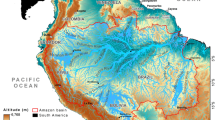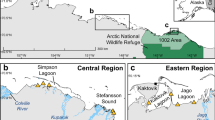Abstract
Atlantic menhaden (Brevoortia tyrannus) is well known for its commercial and ecological importance and has been historically declining in the Chesapeake Bay (Maryland), one of its principal nursery habitats along the eastern coast. Using data from the Striped Bass Seine Survey of the Maryland Department of Natural Resources (2003), we evaluated how the distribution of Atlantic menhaden has changed from 1966 to 2004 for 12 river drainages. We observed significant or marginally significant declines in 42% of the drainages, with drainages of the northern Bay showing the majority of those declines. Continued recruitment to several drainages of the Bay may partly explain why the adult spawning population is not declining. We determined if temporal changes in abundance were related to changes in salinity or water quality for five major drainages of the watershed. For one of these drainages, the Patuxent River, differences in productivity across sites largely explained differences in abundance. For the four remaining drainages, differences in recruitment could not be explained by productivity or salinity gradients. While reducing nitrogen loading and enhancing water clarity may improve Atlantic menhaden production, we suggest that the role of offshore processes on large-scale declines has been largely neglected and studies on larval ingression are necessary for further elucidation of spatial and temporal patterns of juvenile distribution in the Chesapeake Bay.
Similar content being viewed by others
Literature Cited
Ahrenholz, D. W., W. R. Nelson, andS. P. Epperly. 1987. Population and fishery characteristics of Atlantic menhaden,Brevoortia tyrannus.Fishery Bulletin 85:569–600.
Atlantic States Marine Fisheries Commission (ASMFC). 2004. Atlantic menhaden stock assessment report for peer review. ASMFC Report no. 04-01. Raleigh, North Carolina.
Blankenship, K. 1998. Latest data show decline in menhaden, despite spawning potential. Alliance for the Chesapeake Bay, Bay Journal, 8, on-line journal: (www.bayjournal.com/newsite/index.cfm)
Buchanan, C., R. V. Lacouture, H. G. Marshall, M. Olson, andJ. M. Johnson. 2005. Phytoplankton reference communities for Chesapeake Bay and its tidal tributaries.Estuaries 28:138–159.
Christenson, N. L., A. M. Bartuska, J. H. Brown, S. Carpenter, C. D'Antonio, R. Francis, J. F. Franklin, J. A. MacMahon, R. F. Noss, D. J. Parsons, C. H. Peterson, M. G. Turner, andR. G. Woodmansee. 1996. The report of the Ecological Society of America committee on the scientific basis for ecosystem management.Ecological Applications 6:665–691.
Doherty, Jr.,P. F., T. Boulinier, andJ. D. Nichols. 2003. Local extinction and turnover rates at the edge and interior of species' ranges.American Zoology Fennici 40:145–153.
Duarte, C. M., S. Agusti, andN. S. R. Agawin. 2000. Response of a Mediterranean phytoplankton community to increased nutrient inputs: A mesocosm experiment.Marine Ecology Progress Series 195:61–70.
Durbin, A. G. andE. G. Durbin. 1975. Grazing rates of the Atlantic menhadenBrevoortia tyrannus as a function of particle size and concentration.Marine Biology 33:265–277.
Durrell, E. Q. and C. A. Weedon 2003. Striped Bass Seine Survey Juvenile Index web page, Maryland Department of Natural Resources Fisheries Service. www.DNR.state.MD.US/fisheries/juvindex/index.html (October 2004).
Friedland, K. D., D. W. Ahrenholz, andJ. F. Guthrie. 1996. Formation and seasonal evolution of Atlantic menhaden juvenile nurseries in coastal estuaries.Estuaries 19:105–114.
Friedland, K. D., L. W. Haas, andJ. V. Merriner. 1984. Filtering rates of the juvenile Atlantic menhadenBrevoortia tyrannus with consideration of the effects of detritus and swimming speed.Marine Biology 84:109–117.
Gonzalez, E. J. 2000. Nutrient enrichment and zooplankton effects on the phytoplankton community in microcosms from El Andino reservoir (Venezuela).Hydrobiologia 434:81–96.
Harding, L. W. 1994. Long-term trends in the distribution of phytoplankton in Chesapeake Bay: Roles, nutrients and stream-flow.Marine Ecology Progress Series 104:267–291.
Hartman, K. J. andS. B. Brandt. 1995. Predatory demand and impact of striped bass, bluefish and weakfish in Chesapeake Bay: Applications of bioenergetics models.Canadian Journal of Fishery and Aquatic Sciences 52:1667–1687.
Hartman, K. J. andF. J. Margraf. 2003. U.S. Atlantic coast striped bass: Issues with a recovered populations.Fisheries Management and Ecology 10:309–312.
Hettler, W. F. 1976. Influence of temperature and salinity on routine metabolic rate and growth of young Atlantic menhaden.Journal of Fish Biology 8:55–65.
Kramer, D. L. 1987. Dissolved oxygen and fish behaviour.Environmental Biology of Fishes 18:81–92.
Love, J. W. andB. B. Rees. 2002. Seasonal differences in hypoxia tolerance in gulf killifish,Fundulus grandis (Fundulidae).Environmental Biology of Fishes 63:103–115.
Love, J. W., C. M. Taylor, andM. L. Warren, Jr. 2005. Influence of density and dissolved oxygen on condition ofStenonema tripunctatum from intermittent streams.Hydrobiologia 543:113–118.
Luo, J., K. J. Hartman, S. B. Brandt, C. F. Cerco, andT. H. Rippetoe. 2001. A spatially-explicit approach for estimating carrying capacity: An application for the Atlantic menhaden (Brevoortia tyrannus) in Chesapeake Bay.Estuaries 24:545–556.
Maryland Department of Natural Resources (MDDNR). 2003. Basin Overview: Patuxent River. Annapolis, Maryland.
McCune, B. andJ. B. Grace. 2002. Analysis of Ecological Communities. MjM Software Design, Gleneden Beach, Oregon.
McQueen, D. J., J. R. Post, andE. L. Mills. 1986. Trophic relationships in freshwater pelagic ecosystems.Canadian Journal of Fisheries and Aquatic Sciences 43:1571–1581.
National Marine Fisheries Service (NMFS). 2003. Fisheries of the United States, Office of Science and Technology, Fisheries Statistics and Economics Division, Silver Spring, Maryland.
Nicholson, W. R. 1978. Movements and population structure of Atlantic menhaden indicated by tag returns.Estuaries 1:141–150.
Oernolfsdottir, E. B., S. E. Lumsden, andJ. L. Pickney. 2004. Phytoplankton community growth-rate response to nutrient pulses in a shallow turbid estuary, Galveston Bay, Texas.Journal of Plankton Research 26:325–339.
Overton, A. S. 2003. Striped bass predator-prey interactions in the Chesapeake Bay and along the Atlantic Coast. Ph.D. Dissertation, University of Maryland Eastern Shore, Princess Anne, Maryland.
Peters, D. S. andW. E. Schaaf. 1981. Food requirements and sources for juvenile Atlantic menhaden.Transactions of the American Fisheries Society 110:317–324.
Quinlan, J. A., B. O. Blanton, T. J. Miller, andF. E. Werner. 1999. From spawning grounds to the estuary: Using linked individual-based and hydrodynamic models to interpret patterns and processes in the oceanic phase of Atlantic menhadenBrevoortia tyrannus life history.Fisheries Oceanography 8:224–246.
Quinlan, J. A. andL. B. Crowder. 1999. Searching for sensitivity in the life history of Atlantic menhaden: Inferences from a matrix model.Fisheries Oceanography 8:124–133.
Reish, R. L., R. B. Deriso, D. Ruppert, andR. J. Carroll. 1985. An investigation of the population dynamics of Atlantic menhaden (Brevoortia tyrannus).Canadian Journal of Fishery and Aquatic Sciences 42:147–157.
Smith, J. W. 1999a. A large fish kill of Atlantic menhaden,Brevoortia tyrannus, on the North Carolina coast.Journal of the Elisha Mitchell Scientific Society 115:157–163.
Smith, J. W. 1999b. Distribution of Atlantic menhaden,Brevoortia tyrannus, purse-seine sets and catches from southern New England to North Carolina, 1985–96. National Oceanic and Atmospheric Administration Technical Report NMFS 144, U.S. Department of Commerce, Seattle, Washington.
Sokal, R. R. andF. J. Rohlf. 1995. Biometry, 3rd edition. W. H. Freeman and Company, New York.
Taylor, S. L., S. C. Roberts, C. J. Walsh, andB. E. Hatt. 2004. Catchment urbanisation and increased benthic algal biomass in streams: Linking mechanisms to management.Freshwater Biology 49:835–851.
Uphoff, J. H. 2003. Predator-prey analysis of striped bass and Atlantic menhaden in upper Chesapeake Bay.Fisheries Management and Ecology 10:313–322.
Wang, L., J. Lyons, andP. Kanehl. 2003. Impacts of urban land cover on trout streams in Wisconsin and Minnesota.Transactions of the American Fisheries Society 132:825–839.
Warlen, S. M. 1994. Spawning time and recruitment dynamics of larval Atlantic menhaden,Brevoortia tyrannus, into a North Carolina estuary.Fishery Bulletin 92:420–433.
Sources of Unpublished Materials
May, E. personal communication. University of Maryland Eastern Shore, Department of Matural Sciences, Princess Anne, Maryland 21853
Vaughan, D. personal communication. National Oceanic and Atmospheric Administration, 101 Pivers Island Road, Beaufort North Carolina 28516.
Author information
Authors and Affiliations
Corresponding author
Rights and permissions
About this article
Cite this article
Love, J.W., Johnson, A.K. & May, E.B. Spatial and temporal differences of Atlantic menhaden (Brevoortia tyrannus) recruitment across major drainages (1966–2004) of the Chesapeake Bay watershed. Estuaries and Coasts: J ERF 29, 794–801 (2006). https://doi.org/10.1007/BF02786530
Received:
Revised:
Accepted:
Issue Date:
DOI: https://doi.org/10.1007/BF02786530




